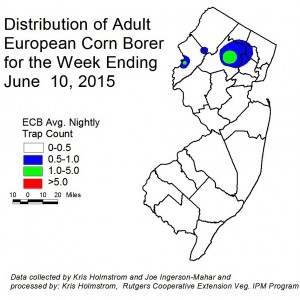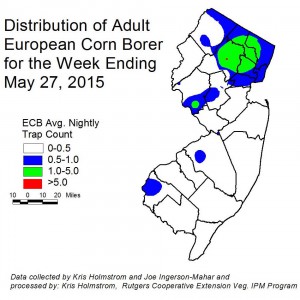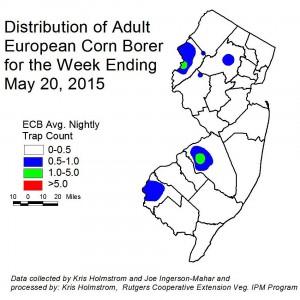Sweet Corn
Catches of European corn borer (ECB) are now in decline through much of the state. Remaining areas of highest activity include parts of Morris and Warren counties (see ECB map).
ECB infestations are now rising in sweet corn plantings. Feeding ranges from single digits to 12% in areas where IPM personnel are operating.
Organic Farm Advisory
The Plant & Pest Advisory serves NJ growers by reporting on important pests and recommending responses that are grounded in reproducible trials.
 Articles in this section contain information helpful to the NJ commercial organic grower.
Articles in this section contain information helpful to the NJ commercial organic grower.
 Sharing organic practice trial results between land-grant universities is a cost effective way to create a common knowledge base built on the strengths of individual programs. In the sidebar, find institutions with programs in organic agriculture which augment knowledge developed at the Rutgers New Jersey Ag Experiment Station.
Sharing organic practice trial results between land-grant universities is a cost effective way to create a common knowledge base built on the strengths of individual programs. In the sidebar, find institutions with programs in organic agriculture which augment knowledge developed at the Rutgers New Jersey Ag Experiment Station.
 Rutgers Cooperative Extension Field Guides: These concise guides help with decision making from pre-planting to harvest. For each crop listed, learn what pests to proactively look for as the season progresses, how to look for them, and when to take action.
Rutgers Cooperative Extension Field Guides: These concise guides help with decision making from pre-planting to harvest. For each crop listed, learn what pests to proactively look for as the season progresses, how to look for them, and when to take action.
Veg IPM Update: Week Ending 6/10/15
Veg IPM Update: Week Ending 6/3/15
Sweet Corn
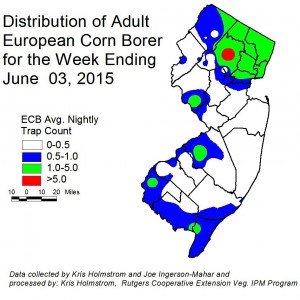 Cold temperatures and rain this week have prevented catches of European corn borer (ECB) from rising, and much of the activity represented in the map occurred over the weekend. Areas of highest activity include parts of Hunterdon, Morris and Burlington counties (see ECB map). Low level ECB infestations are present in early sweet corn plantings, and will become more significant with the return of drier weather.
Cold temperatures and rain this week have prevented catches of European corn borer (ECB) from rising, and much of the activity represented in the map occurred over the weekend. Areas of highest activity include parts of Hunterdon, Morris and Burlington counties (see ECB map). Low level ECB infestations are present in early sweet corn plantings, and will become more significant with the return of drier weather.
[Read more…]
Wet Weather and Strawberry Fruit Rots
Wet weather is expected to come in during the first part of the week and linger around for most of it. Now that strawberries are in full production growers need to pay close attention to fruit rots such as anthracnose and botrytis. Overipe or unharvested mature berries left in commercial or u-pick fields can act as sources of inoculum for both pathogens. Importantly, both pathogens can develop and spread rapidly under wet, rainy conditions and the appropriate protectant fungicides need to be applied ahead of any inclement weather.
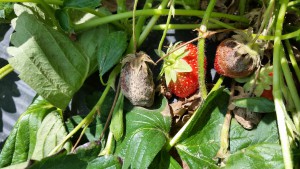
Botrytis, or grey mold, on mature strawberry fruit. Botrytis can develop and spread rapidly under cool, wet conditions.
[Read more…]
Veg IPM Update: Week Ending 5/27/15
Sweet Corn
European corn borer (ECB) adults are being captured with increasing frequency now. Areas of highest activity now include parts of Hunterdon and Morris counties (see ECB map). Within the past 3 days, IPM personnel have found low level ECB infestations in some of the earliest sweet corn plantings. At present, reports of feeding are from Ocean and Somerset counties, however it is likely that feeding is occurring in many early plantings to the south.[Read more…]
Vegetable Disease Update – 5/25/15
Pepper
Bacterial leaf spot – Symptoms of bacterial leaf spot on pepper leaves include small, brown water-soaked lesions that turn brown and necrotic in the centers. Spots may coalesce and form large blighted areas on leaves and premature defoliation can occur. On fruit, brown lesions can form which have a roughened, cracked wart-like appearance. High temperatures, high relative humidity and rainfall favor Bacterial spot development. Loss from Bacterial spot can be reduced somewhat by maintaining high levels of fertility, which will stimulate new growth. Applying a fixed copper (M1) at labeled rates or may help suppress spread. Quintec (quinoxyfen, 13) at 6.0 fl. oz/A is now labeled for the suppression of bacterial leaf spot in pepper in the mid-Atlantic region. Please see the 2015 New Jersey Commercial Vegetable Production Recommendations Guide for more information. [Read more…]
Veg IPM Update: Week Ending 5/20/15
Sweet Corn
European corn borer (ECB) adults are being captured with increasing frequency now. At the present, areas of highest activity include Burlington and Warren counties (see ECB map). Cooler nights for later this week may suppress catches for the next several days.Most early sweet corn plantings are too young to support ECB larval infestations. However, over the next two weeks we should begin to see feeding in the most advanced plantings. Be sure to begin monitoring the earliest plantings for ECB feeding while they are still in the whorl stage. For detailed information see:
| The highest nightly ECB catches for the previous week are as follows: | ||
| Belvidere 2 | Allamuchy 1 | Port Colden 1 |
| Blairstown 2 | Califon 1 | Sergeantsville 1 |
| Denville 2 | Centerton 1 | Tabernacle 1 |
| Medford 2 | Pedricktown 1 | Woodstown 1 |

